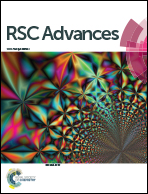Metallic Ti3O5 hierarchical porous microspheres with an enhanced photothermal property†
Abstract
γ-Ti3O5 is one kind of prominent non-stoichiometric metal oxide due to its intriguing ability in electric and electrochemical behaviors. This work reports another attractive property of γ-Ti3O5 hierarchical porous microspheres, the extremely effective photothermal property with a high photothermal conversion efficiency. Theory and experimental results indicate that γ-Ti3O5 hierarchical porous microspheres possess metallic features and display very strong localized surface plasma resonance effects over the visible and near-infrared region. Under simulated sunlight or near infrared light, the metallic γ-Ti3O5 exhibits a photothermal conversion efficiency of up to 65.29%. Under irradiation by a near-infrared laser with a wavelength of 808 nm, the γ-Ti3O5 hierarchical porous microspheres can significantly inhibit cancer cell viability in vitro and disrupt tumor tissue growth in vivo in a short period. In vitro and in vivo toxicity experiments demonstrate that it has good biocompatibility. The ultrahigh photothermal conversion efficiency and biocompatibility make the γ-Ti3O5 very attractive for technological uses in photothermal therapy, solar energy utilization, and infrared light detection and so on.



 Please wait while we load your content...
Please wait while we load your content...